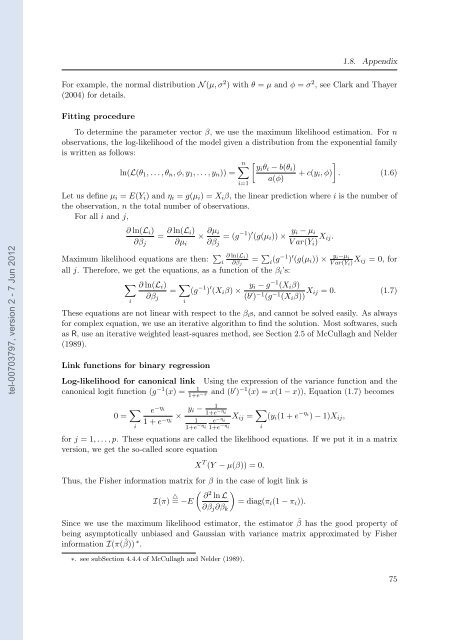Etude des marchés d'assurance non-vie à l'aide d'équilibres de ...
Etude des marchés d'assurance non-vie à l'aide d'équilibres de ...
Etude des marchés d'assurance non-vie à l'aide d'équilibres de ...
Create successful ePaper yourself
Turn your PDF publications into a flip-book with our unique Google optimized e-Paper software.
tel-00703797, version 2 - 7 Jun 2012<br />
1.8. Appendix<br />
For example, the normal distribution N (µ, σ 2 ) with θ = µ and φ = σ 2 , see Clark and Thayer<br />
(2004) for <strong>de</strong>tails.<br />
Fitting procedure<br />
To <strong>de</strong>termine the parameter vector β, we use the maximum likelihood estimation. For n<br />
observations, the log-likelihood of the mo<strong>de</strong>l given a distribution from the exponential family<br />
is written as follows:<br />
ln(L(θ1, . . . , θn, φ, y1, . . . , yn)) =<br />
n<br />
<br />
yiθi − b(θi)<br />
i=1<br />
a(φ)<br />
<br />
+ c(yi, φ) . (1.6)<br />
Let us <strong>de</strong>fine µi = E(Yi) and ηi = g(µi) = Xiβ, the linear prediction where i is the number of<br />
the observation, n the total number of observations.<br />
For all i and j,<br />
∂ ln(Li)<br />
=<br />
∂βj<br />
∂ ln(Li)<br />
×<br />
∂µi<br />
∂µi<br />
∂βj<br />
Maximum likelihood equations are then: ∂ ln(Li) <br />
i = ∂βj<br />
all j. Therefore, we get the equations, as a function of the βi’s:<br />
∂ ln(Li)<br />
=<br />
∂βj<br />
<br />
i<br />
i<br />
= (g −1 ) ′ (g(µi)) × yi − µi<br />
V ar(Yi) Xij.<br />
i (g−1 ) ′ (g(µi)) × yi−µi<br />
V ar(Yi) Xij = 0, for<br />
(g −1 ) ′ (Xiβ) × yi − g−1 (Xiβ)<br />
(b ′ ) −1 (g−1 (Xiβ)) Xij = 0. (1.7)<br />
These equations are not linear with respect to the βis, and cannot be solved easily. As always<br />
for complex equation, we use an iterative algorithm to find the solution. Most softwares, such<br />
as R, use an iterative weighted least-squares method, see Section 2.5 of McCullagh and Nel<strong>de</strong>r<br />
(1989).<br />
Link functions for binary regression<br />
Log-likelihood for ca<strong>non</strong>ical link Using the expression of the variance function and the<br />
ca<strong>non</strong>ical logit function (g −1 (x) = 1<br />
1+e −x and (b ′ ) −1 (x) = x(1 − x)), Equation (1.7) becomes<br />
0 = e−ηi 1 + e−ηi × yi − 1<br />
1<br />
i<br />
1+e−ηi 1+e−η e<br />
i<br />
−ηi 1+e−ηi Xij = <br />
(yi(1 + e −ηi ) − 1)Xij,<br />
for j = 1, . . . , p. These equations are called the likelihood equations. If we put it in a matrix<br />
version, we get the so-called score equation<br />
X T (Y − µ(β)) = 0.<br />
Thus, the Fisher information matrix for β in the case of logit link is<br />
I(π) △ <br />
∂2 ln L<br />
= −E<br />
= diag(πi(1 − πi)).<br />
∂βj∂βk<br />
Since we use the maximum likelihood estimator, the estimator ˆ β has the good property of<br />
being asymptotically unbiased and Gaussian with variance matrix approximated by Fisher<br />
information I(π( ˆ β)) ∗ .<br />
∗. see subSection 4.4.4 of McCullagh and Nel<strong>de</strong>r (1989).<br />
i<br />
75
















